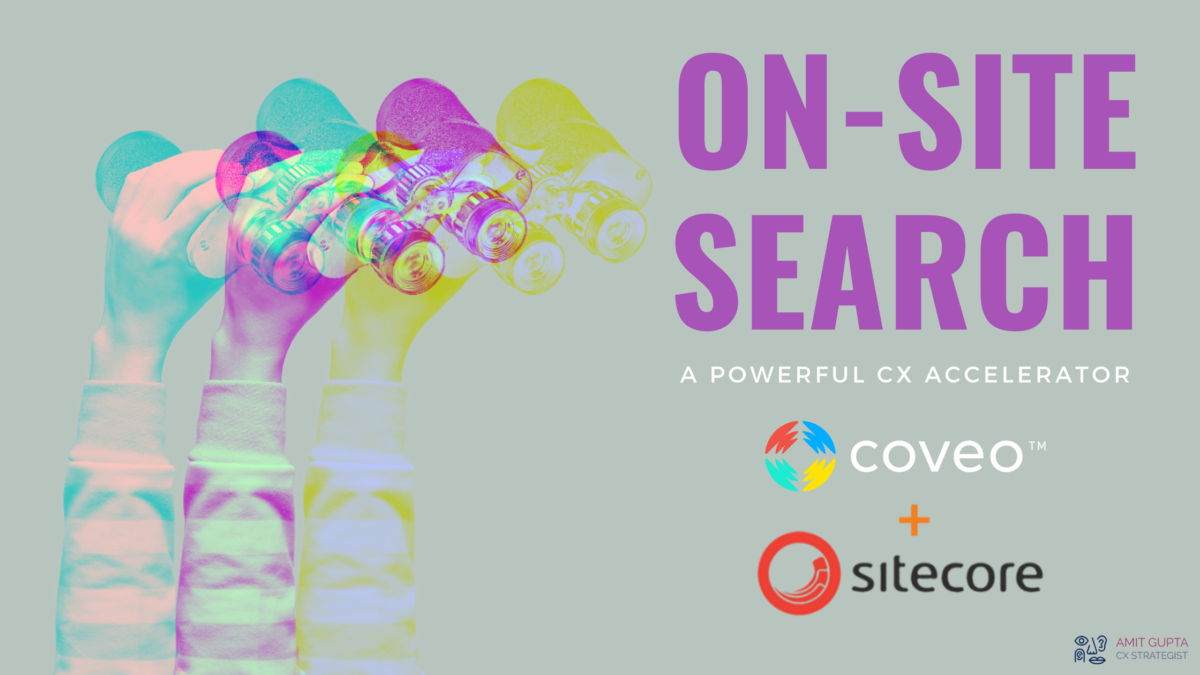Most websites have a search capability wherein visitors enter a few keywords and find the content they are looking for with ease. We call this as On-site search.
Ever wondered how leading brands use the humble On-site search feature to deliver a power packed customer experience?
First, let us look at the different approaches of setting up On-site search;
- Open Source / Free providers : Suitable for small businesses / individuals
- Software as a Service : Suitable for mid-scale businesses
- Enterprise Site Search: Suitable for large organizations / brands with rich content and content management capabilities
We must note, not every organization goes for the options listed above. Some companies will customize an open source solution into their own home grown solution. Sky is the limit in terms of creativity.
In this post, I am going to focus on enterprise On-site search solutions such as #Coveo and Supersonic CMS systems such as #Sitecore as the maturity of these platforms and their associated features are most aligned to the questions I am answering.
“How can we use On-site search to improve the experience of website visitors?”
- Help your visitors find what they seek: Of course, that’s the primary purpose of a search engine. Helping users find the information they are seeking, quickly. Now let’s flip this around and ask, what happens when users can’t find what they are searching for? They get frustrated, disappointment creeps in and eventually they walk away. It is important we clarify this first, no On-site search feature is worth anything if it does not deliver on this basic feature. It has to find what your visitors are looking for.
- Understand what they couldn’t find: It is natural and possible, that you do not have all the information your visitors are looking for on your website yet. This is called a Content Gap. Coveo does a fantastic job in reporting these Content Gaps. It’s a goldmine of insight for every Digital Content Strategy team as they uncover the terms that did not fetch results. Most importantly, it is also a phenomenal CX solution because a content gap is a moment of disappointment and we have an opportunity to fix it to avoid repeating it in the future.
- Regional Business Intelligence: Understanding what visitors are searching for provides strategic guidance and business intelligence (BI) to fuel data driven decisions. A deeper understanding of what people are searching for or struggling to find and when a search is triggered could help pin-point to important experience issues. For example, If customers suddenly search for installation related issues soon after the release of a new model may signify an opportunity to improve any installation guides that were sent with the product.
- Predictive Personalization: Joe Pine, the godfather of the experience economy and my coach shared his insight on Personalization. According to the legend himself, Customization is core to experiences. When you personalize or customize experiences you can’t help but engage people. “It makes them feel special,” explains Joe. “They know that you’ve done it just for them.
This is the sweet spot where Sitecore + Coveo can boost your experiences by leveraging their personalization and AI capabilities.
Let’s articulate the example of an e-commerce store. If your visitors search “red shirts” on your website using the on-site search feature. They expect to land on a list of products where you displayed all the “red shirts” you sell. You will need some mechanism to figure out which “red shirt” in particular should be the first recommended display. Most On-Site search engines have inbuilt algorithms that will display red shirts and rank them by relevance. Most algorithms would decide the rank and relevance based on the keywords within your content.
This is where platforms such as Coveo can leverage their AI capabilities and club together with Sitecore’s Experience Profile Analytics to automatically recommend a particular SKU / collection of SKUs to the visitor considering a broad list of factors such as
- The customers past purchase / browsing history (If they like short sleeved shirts or full sleeved shirts)
- What Customers like them purchased / browsed in the past
Both of these platforms have Artificial Intelligence baked into their ecosystems right out of the box and are simply waiting for the data driven experience designer to leverage them and deliver a compelling personalized experience that matters.

